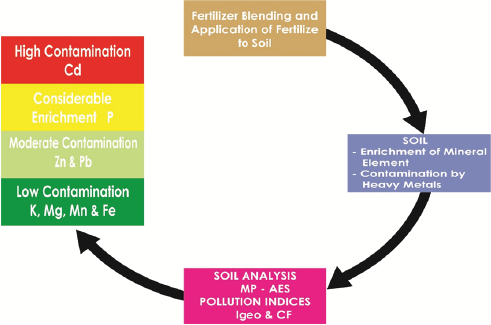Levels and ecological risk assessment of mineral and heavy metals in soils around Nasara Fertilizer Blending Plant, Lafia, Nigeria
DOI:
https://doi.org/10.52493/j.cote.2022.2.30Keywords:
Soil pollution, potentially toxic metals, geo-accumulation index, contamination assessmentAbstract
Fertilizer introduction in the right elemental proportion based on plants' nutritional needs has contributed positively to crop production. On the other hand, the leakages during fertilizer blending have contributed to excessive mineral nutrients and traces of heavy metals in the environment. These leakages contaminate water bodies or get into the food chain and bio-cumulate in tissues of living organisms with detrimental effects. This study assessed the impact of fertilizer blending on the level of some mineral and heavy metals in soils around the industrial layout using MP-AES, pollution indices in terms of the geo-accumulation index and contamination factor. The results revealed all of the mineral and heavy metals were detected in the soil in the order of abundance: Fe (10560.77±8.00 mg/kg), P (5252.17±36.15 mg/kg), K (1834.53±13.74 mg/kg), Mg (593.99±13.75 mg/kg), Mn (335.18±1.63 mg/kg), Zn (205.96±1.18 mg/kg), Pb (20.08±0.19 mg/kg) and Cd (6.51±0.06 mg/kg). There was a significant difference in soil quality, mineral and heavy metal content between the test and control soil samples (P < 0.05). The geo-accumulation index showed moderate contamination by phosphorus and strong to extreme contamination by cadmium. The contamination factor showed the soil is moderately contaminated with zinc and lead, considerably contaminated with phosphorus but highly contaminated with cadmium, a very toxic element that distributes so easily in soil and plant tissues. Hence, consumption of crops, fruits and vegetables from the area may likely be at risk. Regular monitoring and effective clean up are recommended.
References
Agbaji, E. B., Abechi, S. E., & Emmanuel, S. A. (2015). Assessment of heavy metals level of soil in Kakuri industrial area of Kaduna, Nigeria. J Sci Res Rep [Internet], 4(1), 68-78. https://doi.org/10.9734/JSRR/2015/13212
Akomolafe, G. F., & Lawal, S. (2019). Heavy metal accumulation in some plants growing at polluted soils in Lafia, Nigeria. FUDMA Journal of Sciences, 3(2), 9-14.
Al-Saedi, S. A., Razaq, I. B., & Ali, N. A. (2016). Effect of soil textural classes on the biological nitrogen fixation by Bradyrhizobium measured by 15N dilution analysis. Baghdad Science Journal, 13(4). https://www.iasj.net/iasj/article/117584
Arowojolu, I. M., Tongu, S. M., Itodo, A. U., Sodre, F. F., Kyenge, B. A., & Nwankwo, R. C. (2021). Investigation of sources, ecological and health risks of sedimentary polycyclic aromatic hydrocarbons in River Benue, Nigeria. Environmental technology & innovation, 22, 101457. https://doi.org/10.1016/j.eti.2021.101457
Barbalace, K. (2007). Periodic Table of Elements. Retrieved from https://www.EnvironmentalChemistry.com
Bray, R.H. & Kurtz, L.T. (1945). Determination of total organic and available forms of phosphorus in soils. Soil Science, 59, 30–45. https://journals.lww.com/soilsci/Citation/1945/01000/Determination_of_Total,_Organic,_and_Available.6.aspx
Edith-Etakah, B.T., Shapi, M., Penaye, J., Mimba, M.E., NguemheFils, S.C., Nadasan, D.S. Davies, T.C. & Jordaan, M.A. (2017). Background Concentrations of Potentially Harmful Elements in Soils of the Kette-Batouri Region, Eastern Cameroon. Research Journal of EnvironmentalToxicology, 11, 40-54. https://doi.org/10.3923/rjet.2017.40.54
Finch, H. J. S., Samuel, A. M. & Lane, P. F. (2014). Fertilizers and manures. In: Lockhart and Wiseman’s crop husbandry including grassland 9th edition, Woodhead Publishers pp. 63-91.
Guan, Y., C. Shao & M. Ju, 2014. Heavy metal contamination assessment and partition for industrial and mining gathering areas. Int. J. Environ. Res. Public Health, 11, 7286-7303. https://doi.org/10.3390/ijerph110707286
Ismael, M.A., Elyamine, A.M., Moussa, M.G., Cai, M., Zhao, X. & Hu, C. (2019). Cadmium in plants: uptake, toxicity, and its interactions with selenium fertilizers. Metallomics, 11(2), 255-277. https://doi.org/10.1039/c8mt00247a
Iwegbue, C.M.A., Bassey, F.I., Tesi, G.O., Nwajei, G.E. & Tsafe, A.I. (2013). Assessment of Heavy Metal Contamination in Soils around Cassava Processing Mills in Sub-Urban Areas of Delta State, Southern Nigeria. Nigerian Journal of Basic and Applied Science, 21(2), 96-104. http://doi.org/10.4314/njbas.v21i2.2
Johnston, A.E., Poulton, P.R. & Coleman, K. (2009). Soil organic matter: Its importance in sustainable agriculture and carbon dioxide fluxes. Advances in Agronomy, 101, 1-57. https://doi.org/10.1016/S0065-2113(08)00801-8
Joseph, J. W. & Ganga, M. H. (2019). A Review of the Latest in Phosphorus Fertilizer Technology: Possibilities and Pragmatism. J Environ Qual; 48(5), 1300-1313. https://doi.org/10.2134/jeq2019.02.0067
Mar, S.S. & Okazaki, M. (2012). Investigation of Cd in several phosphate rocks used for the production of fertilizer. Microchemical Journal, 104, 17-21. https://doi.org/10.1016/j.microc.2012.03.020
Meng, M. Yang, L., Wei, B., Li, H. & Yu, J. (2018). Contamination assessment and spatial distribution of heavy metals in greenhouse soils in China. J. Ecol. Rural Environ., 34, 1019–1026. https://doi.org/10.11934/j.issn.1673-4831.2018.11.009
Mirlean, N. & Roisenberg, A. (2006). The effect of emissions of fertilizer production on the environment contamination by cadmium and arsenic in southern Brazil. Environmental Pollution, 143 (2), 335-340. https://doi.org/10.1016/j.envpol.2005.11.022
Moore, F, Forghani G. & Qishlaqi A (2009). Assessment of heavy metal contamination in water and surface sediments of the Maharlu saline Lake, Swiran. Iran J. Sci. Tech. Trans A 33(A1), 43–55. https://ijsts.shirazu.ac.ir/article_2201_fa539d01a4a30476b13b4cababb21e5b.pdf
Motsara, M.R. & Roy, R.N. (2008). Guide to laboratory establishment for plant nutrient analysis. FAO Fertilizer and Plant Nutrition Bulletin, 19, 17-22.
Muller, G. (1969). Index of geoaccumulation in sediments of the Rhine River. Geology Journal 2, 108–118.
Ohaeri, J.E. & Eshett E.T. (2011) Phosphorus forms and distribution in selected soils formed over different parent materials in Abia State of Nigeria. Journal of Tropical Agriculture, Food, Environment and Extension, 10(3), 28 – 37. http://dx.doi.org/10.431/as.v10i3.4
Pam, A.A., Sha’Ato, R. & Offem, J.O. (2013). Evaluation of heavy metals in soils around auto mechanic workshop clusters in Gboko and Makurdi, Central Nigeria. Journal Environmental Chemistry and Ecotoxicology, 5(11), 298-306. https://doi.org/10.5897/JECE2013.0295
Raj, S.P. & Ram, P.A. (2013). Determination and contamination assessment of Pb, Cd and Hg in roadside dust along Kathmandu-Bhaktapur road section of Arniko Highway, Nepal. Research Journal of Chemical Science, 3(9), 18–25.
Rahman, S.H., Khanam, D., Adyel, T.M., Islam, M.S., Ahsan, M.A. & Akbor, M.A. (2012). Assessment of Heavy Metal Contamination of Agricultural Soil around Dhaka Export Processing Zone (DEPZ), Bangladesh: Implication of Seasonal Variation and Indices. Applied Sciences, 2, 584-601. https://doi.org/10.3390/app2030584
Rathore, S.P.S., Bhargava, P.K., Kumar, M. & Talra, R.K. (1993). Indicator for the titrimetric determination of calcium and total calcium plus magnesium with ethylenediaminetetraacetate in water. Analytica Chimica Acta, 281(1), 173-177. https://doi.org/10.1016/0003-2670(93)85351-J
Requejo, M.I. & Eichler-Löbermann, B. (2014). Organic and inorganic phosphorus forms in soil as affected by long-term application of organic amendments. Nutr. Cycl. Agroecosyst, 100, 245–255. https://doi.org/10.1007/s10705-014-9642-9
Saeed, K.S., Ahmed, S.A., Hassan, I.A. & Ahmed, P.H. (2015). Effect of Bio-fertilizer and Chemical Fertilizer on Growth and Yield in Cucumber (Cucumis sativus) in Green House Condition. Pakistan Journal of Biological Sciences, 18, 129-134. http://greenbiotech-co.com/flsimgs/greenbio/2/files/194.pdf
Selassie, G.Y. (2015). Are mineral fertilizers panacea for increase in crop yield? Journal of Agricultural and Environmental Science, 1(1), 61-71.
Sharma, P. & Dubey, R. S. (2005). Lead toxicity in plants. Brazilian Journal of Plant Physiology, 17: 35-52. Available: https://www.scielo.br/pdf/bjpp/v17n1/a04v17n1
Sharma, R., Patel, S.K., Lata, L. & Milosh, H. (2016). Characterization of Urban Soil with SEM-EDX. Scientific Research, 7(10), 724-735. https://doi.org/10.4236/ajac.2016.710065
Sharpley, A., Jarvie, H., Flaten, D. & Kleinman, P. (2018). Celebrating the 350th anniversary of phosphorus discovery: A conundrum of deficiency and excess. Journal of Environmental Quality, 47, 774–777. https://doi.org/10.2134/jeq2018.05.0170
Singh, R. P. & Kumar, A. (2014). Environmental Exposures and Toxic Effects of Cadmium: A Review. Asian J. of Adv. Basic Sci., 3(1), 217-221
Spann, T.M. & Shumann, A.W. (2013). Mineral nutrition contributes to plant disease and pest resistance. HS1181 Horticultural Science Department, University of florida, IFAS extension series, pp. 1 - 4. https://journals.flvc.org/edis/article/download/118663/116587
Tiruta-Barna, L. & Barna, R. (2013). Assessing the potential environmental hazards of concrete made using recycled aggregates (RAs). Handbook of Recycled Concrete and Demolition Waste, Woodhead Publishing Series in Civil and Structural Engineering. pp. 605 - 629. https://doi.org/10.1533/9780857096906.4.605
Turgut, C., Pepe, M. K. & Curtright, T. J. (2004). The effects of EDTA and citric acid on phytoremediation of Cd, Cr, and Ni from soil using Helianthus annuus, Environmental Pollution, 131, 147-154. https://doi.org/10.1016/j.envpol.2004.01.017
Kaur, H and Garg, N. (2021). Zinc toxicity in plants: a review. Planta; 253(6):129. https://doi.org/10.1007/s00425-021-03642-z
Khan, A. B. & Kathi, S. (2014). Evaluation of heavy metal and total petroleum hydrocarbon contamination of roadside surface soil. Int. J. Environ. Sci. Technol., 11, 2259 –2270. https://doi.org/10.1007/s13762-014-0626-8
United States Department of Agriculture (USDA). (1993). Soil survey manual (No. 18). US Department of Agriculture.
Walkley, A. & Black, I. A. (1934). An Examination of the Degtjareff Method for Determining Organic Carbon in Soils: Effect of Variations in Digestion Conditions and Inorganic Soil Constituents. Soil Science, 63, 251 – 263.
Xue, X.J. & Cheng, H.X. (2001). Global Geochemical Mapping and its Implementation in the Asia-Pacific Region. Appl. Geochem., 16, 1309-1321. https://doi.org/10.1016/S0883-2927(01)00051-8
Upadhyay, S. & Raghubanshi, A.S. (2020). Determination of soil carbon dynamics in urban ecosystem. Urban Ecology, pp. 299-314. https://doi.org/10.1016/B978-0-12-820730-7.00016-1
Yerima, E.A., Itodo, A.U., Sha’Ato, R. & Wuana, R.A. (2020). Ecological risk assessment of mineral and heavy metals levels of soil around auto mechanic village Wukari, Nigeria. Academic Journal of Chemistry, 5(7), 81-90. https://ideas.repec.org/a/arp/ajcarp/2020p81-90.html
Zhang, J. & Liu, C.L. (2002). Riverine composition and estuarine geochemistry of particulate metals in China-Weathering features anthropogenic impact and chemical fluxes. Estuarine Coastal and Shelf Science, 54(6), 1051-1070. https://doi.org/10.1006/ecss.2001.0879
Zhang, J., Li, H., Zhou, Y., Dou, L., Cai, L., Mo, L. & You, J. (2018). Bioavailability and soil-to-crop transfer of heavy metals in farmland soils: A case study in the Pearl River Delta, South China. Environ. Pollut., 235, 710–719. https://doi.org/10.1016/j.envpol.2017.12.106

Downloads
Published
Issue
Section
License
Copyright (c) 2022 Emmanuel Yerima, Adams U. Itodo, Rufus Sha’Ato, Raymond A Wuana

This work is licensed under a Creative Commons Attribution 4.0 International License.


